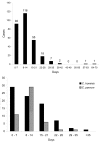Sporadic cryptosporidiosis case-control study with genotyping
- PMID: 15324544
- PMCID: PMC3323324
- DOI: 10.3201/eid1007.030582
Sporadic cryptosporidiosis case-control study with genotyping
Abstract
We report a case-control study of sporadic cryptosporidiosis with genotyping of isolates from case-patients. A postal questionnaire was completed by 427 patients and 427 controls. We obtained genotyping data on isolates from 191 patients; 115 were Cryptosporidium hominis, and 76 were C. parvum. When all cryptosporidiosis cases were analyzed, three variables were strongly associated with illness: travel outside the United Kingdom, contact with another person with diarrhea, and touching cattle. Eating ice cream and eating raw vegetables were both strongly negatively associated with illness. Helping a child <5 years of age to use the toilet and the number of glasses of tap water drunk at home each day were also independently positively associated with risk. Eating tomatoes was negatively associated. For C. hominis infections, the strongly significant risk factors were travel abroad and changing diapers of children <5 years of age. For C. parvum, eating raw vegetables and eating tomatoes were strongly negatively associated with illness; touching farm animals was associated with illness.
Figures
Similar articles
-
The epidemiology of sporadic human infections with unusual cryptosporidia detected during routine typing in England and Wales, 2000-2008.Epidemiol Infect. 2012 Apr;140(4):673-83. doi: 10.1017/S0950268811000860. Epub 2011 Jun 7. Epidemiol Infect. 2012. PMID: 21733255
-
Health sequelae of human cryptosporidiosis in immunocompetent patients.Clin Infect Dis. 2004 Aug 15;39(4):504-10. doi: 10.1086/422649. Epub 2004 Aug 2. Clin Infect Dis. 2004. PMID: 15356813
-
Epidemiology of anthroponotic and zoonotic human cryptosporidiosis in England and Wales, 2004-2006.Epidemiol Infect. 2011 May;139(5):700-12. doi: 10.1017/S0950268810001688. Epub 2010 Jul 12. Epidemiol Infect. 2011. PMID: 20619076
-
Molecular epidemiology of cryptosporidiosis: an update.Exp Parasitol. 2010 Jan;124(1):80-9. doi: 10.1016/j.exppara.2009.03.018. Epub 2009 Apr 7. Exp Parasitol. 2010. PMID: 19358845 Review.
-
Molecular epidemiology of human cryptosporidiosis.Parassitologia. 2005 Jun;47(2):185-92. Parassitologia. 2005. PMID: 16252472 Review.
Cited by
-
Public health risks associated with food-borne parasites.EFSA J. 2018 Dec 4;16(12):e05495. doi: 10.2903/j.efsa.2018.5495. eCollection 2018 Dec. EFSA J. 2018. PMID: 32625781 Free PMC article.
-
Application of a new multi-locus variable number tandem repeat analysis (MLVA) scheme for the seasonal investigation of Cryptosporidium parvum cases in Wales and the northwest of England, spring 2022.Curr Res Parasitol Vector Borne Dis. 2023 Oct 18;4:100151. doi: 10.1016/j.crpvbd.2023.100151. eCollection 2023. Curr Res Parasitol Vector Borne Dis. 2023. PMID: 38021189 Free PMC article.
-
Interventions to improve disposal of child faeces for preventing diarrhoea and soil-transmitted helminth infection.Cochrane Database Syst Rev. 2019 Sep 24;9(9):CD011055. doi: 10.1002/14651858.CD011055.pub2. Cochrane Database Syst Rev. 2019. PMID: 31549742 Free PMC article.
-
Serological responses to Cryptosporidium-specific antigens in Czech populations with different water sources.Epidemiol Infect. 2008 Feb;136(2):279-86. doi: 10.1017/S0950268807008370. Epub 2007 Mar 30. Epidemiol Infect. 2008. PMID: 17394676 Free PMC article.
-
Using a Geographical Information System to investigate the relationship between reported cryptosporidiosis and water supply.Int J Health Geogr. 2004 Jul 23;3(1):15. doi: 10.1186/1476-072X-3-15. Int J Health Geogr. 2004. PMID: 15272942 Free PMC article.
References
-
- Djuretic T, Wall PG, Ryan MJ, Evans HS, Adak GK, Cowden JM. General outbreaks of infectious intestinal disease in England and Wales: 1992 to 1994. Commun Dis Rep CDR Rev. 1996;6:R57–63. - PubMed
-
- Evans HS, Madden P, Douglas C, Adak GK, O’Brien SJ, Djuretic T, et al. General outbreaks of infectious intestinal disease in England and Wales: 1995 and 1996. Commun Dis Public Health. 1998;1:165–71. - PubMed
-
- Hunter PR, Syed Q, Naumova EN. Possible undetected outbreaks of cryptosporidiosis in areas of the North West of England supplied by an unfiltered surface water source. Commun Dis Public Health. 2001;4:136–8. - PubMed
Publication types
MeSH terms
LinkOut - more resources
Full Text Sources
Medical
Miscellaneous

